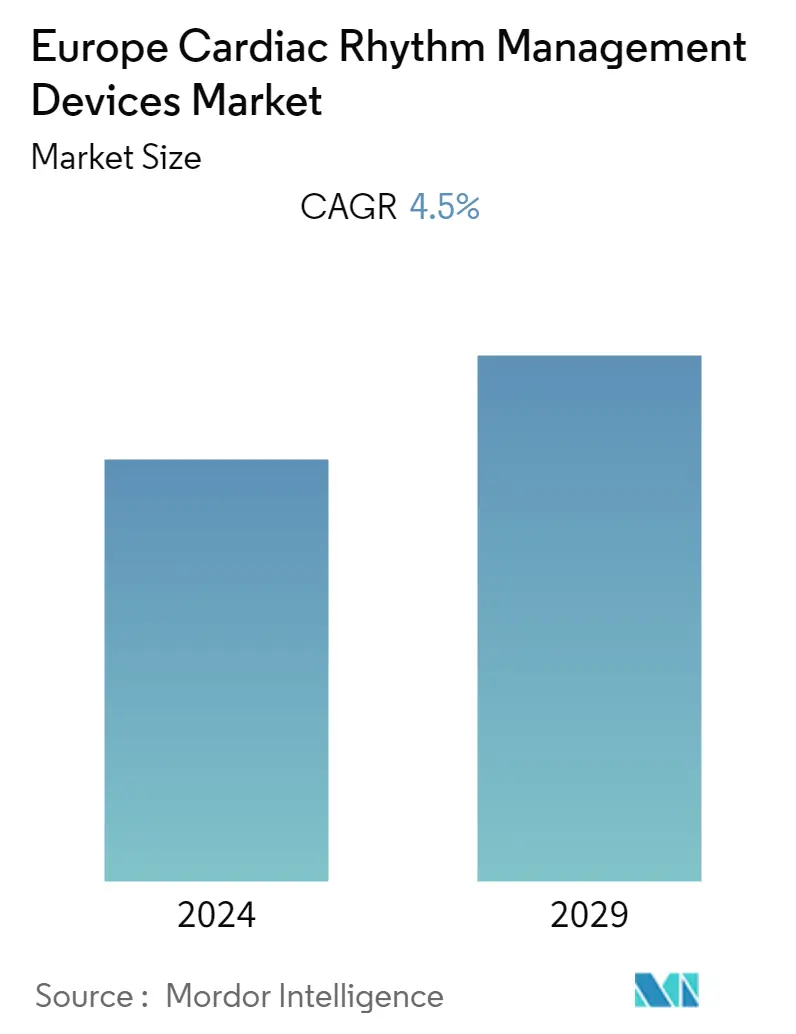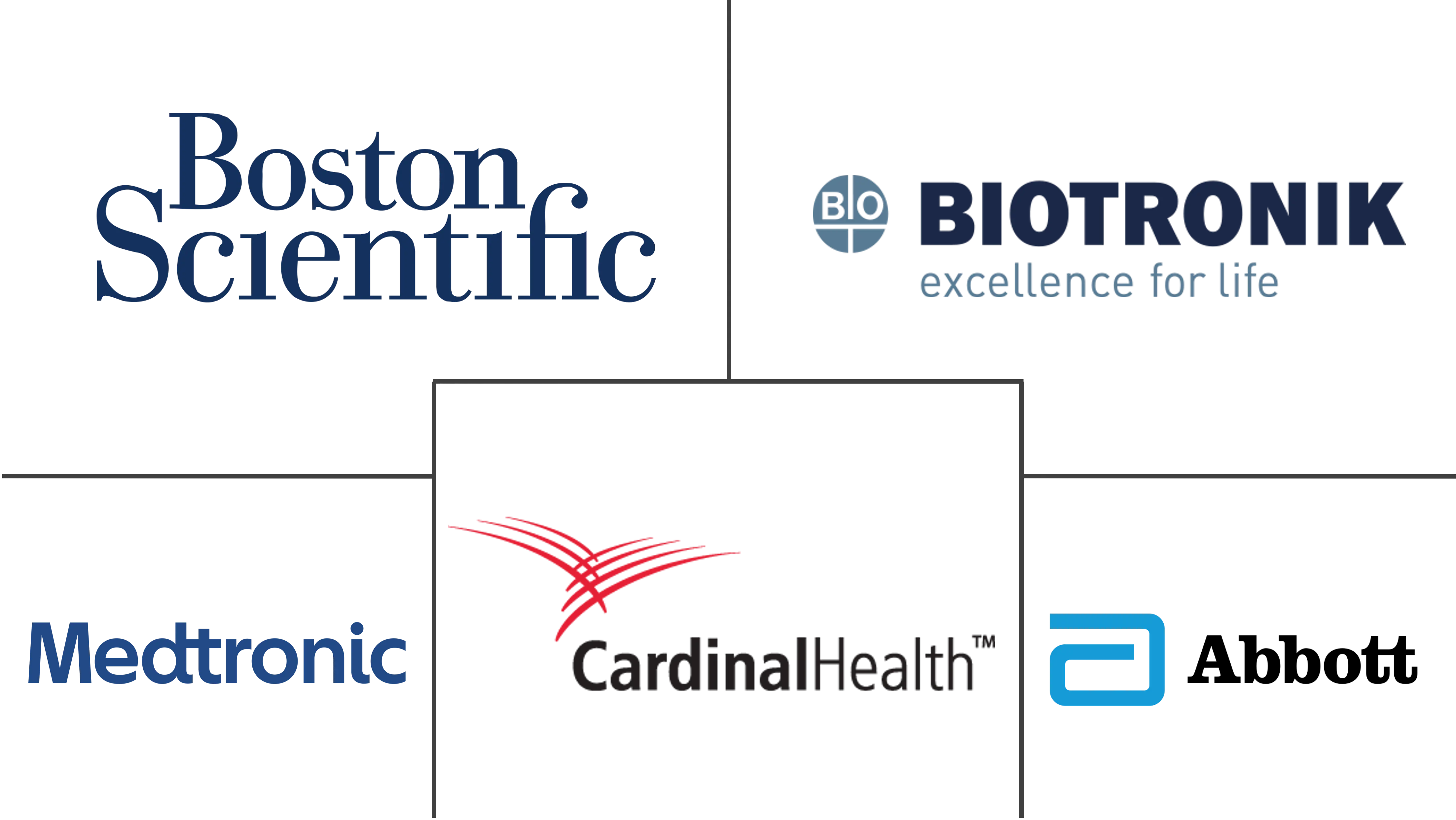Market Size of Europe Cardiac Rhythm Management Devices Industry

| Study Period | 2019 - 2029 |
| Base Year For Estimation | 2023 |
| Forecast Data Period | 2024 - 2029 |
| Historical Data Period | 2019 - 2022 |
| CAGR | 4.50 % |
| Market Concentration | Low |
Major Players
*Disclaimer: Major Players sorted in no particular order |
Europe Cardiac Rhythm Management Devices Market Analysis
The European cardiac rhythm management devices market is expected to register a CAGR of 4.5% during the forecast period.
The emergence of the COVID-19 pandemic led to the lockdown restrictions in the region that affected the diagnosis and monitoring of cardiovascular diseases and the logistics and supply chain of medical devices, including cardiac rhythm management devices, which affected the market growth. For instance, as per the article published in BMJ journal in August 2021, the number of imaging diagnostic procedures for cardiovascular disorders decreased by 45% in the early stages of the pandemic and by 69% in the later stages of the pandemic in the European region.
However, relaxed lockdowns and the resumption of healthcare practices are expected to accelerate market growth in the post-pandemic scenario. For instance, the revenue of the Cardiac Rhythm and Heart Failure segment of Medtronic increased from USD 5,584 million in 2021 to USD 5,908 million in 2022. Also, people with underlying cardiovascular conditions are more prone to severe COVID-19 and long-term risks, such as stroke, arrhythmias, and myocarditis, among others. Thus, the demand for CRM devices is expected to grow in the post-pandemic period.
The market has shown consistent growth owing to the increasing prevalence of cardiovascular disorders, technological advancements, and the rise in the use of ambulatory and home services for cardiac monitoring. The increasing prevalence of cardiovascular disorders is one of the major factors driving the cardiac rhythm management devices market. For instance, as per the BHF 2022 report, vascular dementia affected at least 150,000 people in the United Kingdom in 2022, and the number is predicted to rise to 350,000 by 2030. Hence, the high prevalence of cardiac diseases in European countries is anticipated to be the driving factor for the cardiac rhythm management devices market. Risk factors include smoking, obesity, lack of exercise, high cholesterol, high blood pressure, and diabetes.
Additionally, the German Heart Surgery Report 2021 stated that considering the range of heart operations per 100,000 inhabitants showed a minimum of 96.3 (Baden-Württemberg, population: 11,123,393) and a maximum of 156.1 (Sachsen-Anhalt, population: 2,172,221), while the nationwide mean value at the end of 2021 was 109.9. Thus, the increasing cases of cardiovascular diseases across Europe are driving the growth of the market.
Due to technological innovations and product launches, cardiac rhythm management devices are anticipated to witness strong growth in the study period. The adoption of cardiac rhythm management devices is likely to increase in hospital and home care settings. For instance, in April 2021, Colruyt Group established that more than 60 shops of Spar Colruyt Group in Belgium were anticipated to install automatic external defibrillator devices after successful crowdfunding with the motto 'Your Spar has a heart for the neighborhood.' Additionally, with the advancement in heart rhythm management technology, in April 2022, Boston expanded its digital offering with the European launch of Heart Connect. It is among the newest tools in a growing market for remote management and support in heart rhythm management. Hence, considering technological advancements and the adoption of home-based cardiac monitoring care, the market is anticipated to grow in the forecast period. However, the high cost of cardiovascular devices is likely to restrain the market growth.
Europe Cardiac Rhythm Management Devices Industry Segmentation
As per the scope of the report, cardiac rhythm management is part of electrophysiology. It is used to manage the functioning of the heart. Cardiac rhythm management devices perform many functions, including bradycardia pacing, monitoring for arrhythmias, cardiac resynchronization for heart failure, defibrillation, and anti-tachycardia pacing for tachyarrhythmias. The last decade has observed an ongoing evolution in the use of cardiac rhythm management devices, including cardiac resynchronization therapy, pacemakers, implantable cardioverter defibrillators, and loop recorders. General practitioners (GP) are increasingly involved in the follow-up and management of patients with these devices.
The European cardiac rhythm management devices market is segmented by Product (Defibrillators (Implantable Cardioverter Defibrillators (ICDS) and External Defibrillators (ED)), Pacemakers (Implantable Pacemakers (ICPS) and External Pacemakers), and Cardiac Resynchronization Therapy Devices (Cardiac Resynchronization Therapy Defibrillators (CRT-D) and Cardiac Resynchronization Therapy Pacemakers (CRT-P))) and Geography (Germany, United Kingdom, France, Italy, Spain, Rest of Europe). The report offers the value in USD million for the above segments.
| By Product | ||||
| ||||
| ||||
|
| Geography | |
| Germany | |
| United Kingdom | |
| France | |
| Italy | |
| Spain | |
| Rest of Europe |
Europe Cardiac Rhythm Management Devices Market Size Summary
The European cardiac rhythm management devices market is poised for steady growth, driven by the increasing prevalence of cardiovascular disorders and technological advancements in the field. The market experienced disruptions during the COVID-19 pandemic due to lockdowns and supply chain challenges, which temporarily hindered its expansion. However, the resumption of healthcare services and the heightened awareness of cardiovascular risks associated with COVID-19 are expected to bolster demand for these devices. The market is characterized by a rise in ambulatory and home-based cardiac monitoring services, which are becoming increasingly popular. Technological innovations, such as the launch of new digital tools and remote management systems, are further propelling market growth. Despite the high cost of these devices posing a potential barrier, the overall outlook remains positive, with significant opportunities for expansion in both hospital and home care settings.
The external defibrillator segment is anticipated to witness notable growth, fueled by the rising incidence of cardiac diseases and advancements in cardiology technology. The presence of advanced healthcare infrastructure and government initiatives across Europe, particularly in the United Kingdom, is expected to drive the adoption of external defibrillators. The market is highly competitive, with major players like Abbott, Biotronik SE & Co KG, and Medtronic leading the charge through strategic collaborations, mergers, and product innovations. The United Kingdom, with its developed healthcare system and increasing burden of cardiovascular diseases, is likely to hold a significant market share. The introduction of innovative devices, such as personal defibrillators and leadless pacemaker systems, underscores the dynamic nature of the market and the ongoing efforts to enhance patient outcomes in cardiac care.
Europe Cardiac Rhythm Management Devices Market Size - Table of Contents
-
1. MARKET DYNAMICS
-
1.1 Market Overview
-
1.2 Market Drivers
-
1.2.1 Increasing Prevalence of Cardiovascular Disorders
-
1.2.2 Technological Advancements
-
1.2.3 Rise in the Use of Ambulatory and Home Services for Cardiac Monitoring
-
-
1.3 Market Restraints
-
1.3.1 High Cost of Devices
-
-
1.4 Porter's Five Force Analysis
-
1.4.1 Threat of New Entrants
-
1.4.2 Bargaining Power of Buyers/Consumers
-
1.4.3 Bargaining Power of Suppliers
-
1.4.4 Threat of Substitute Products
-
1.4.5 Intensity of Competitive Rivalry
-
-
-
2. MARKET SEGMENTATION (Market Size by Value - USD million)
-
2.1 By Product
-
2.1.1 Defibrillators
-
2.1.1.1 Implantable Cardioverter Defibrillators (ICDS)
-
2.1.1.2 External Defibrillators (ED)
-
-
2.1.2 Pacemakers
-
2.1.2.1 Implantable Pacemakers (ICPS)
-
2.1.2.2 External Pacemakers
-
-
2.1.3 Cardiac Resynchronization Therapy Devices
-
2.1.3.1 Cardiac Resynchronization Therapy Defibrillators (CRT-D)
-
2.1.3.2 Cardiac Resynchronization Therapy Pacemakers (CRT-P)
-
-
-
2.2 Geography
-
2.2.1 Germany
-
2.2.2 United Kingdom
-
2.2.3 France
-
2.2.4 Italy
-
2.2.5 Spain
-
2.2.6 Rest of Europe
-
-
Europe Cardiac Rhythm Management Devices Market Size FAQs
What is the current Europe Cardiac Rhythm Management Devices Market size?
The Europe Cardiac Rhythm Management Devices Market is projected to register a CAGR of 4.5% during the forecast period (2024-2029)
Who are the key players in Europe Cardiac Rhythm Management Devices Market?
Boston Scientific Corporation, Biotronik SE & Co KG, Cardinal Health, Medtronic and Abbott are the major companies operating in the Europe Cardiac Rhythm Management Devices Market.

